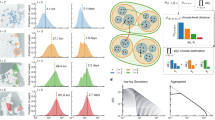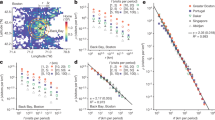Abstract
Individual human trajectories are characterized by fat-tailed distributions of jump sizes and waiting times, suggesting the relevance of continuous-time random-walk (CTRW) models for human mobility. However, human traces are barely random. Given the importance of human mobility, from epidemic modelling to traffic prediction and urban planning, we need quantitative models that can account for the statistical characteristics of individual human trajectories. Here we use empirical data on human mobility, captured by mobile-phone traces, to show that the predictions of the CTRW models are in systematic conflict with the empirical results. We introduce two principles that govern human trajectories, allowing us to build a statistically self-consistent microscopic model for individual human mobility. The model accounts for the empirically observed scaling laws, but also allows us to analytically predict most of the pertinent scaling exponents.
This is a preview of subscription content, access via your institution
Access options
Subscribe to this journal
Receive 12 print issues and online access
$209.00 per year
only $17.42 per issue
Buy this article
- Purchase on Springer Link
- Instant access to full article PDF
Prices may be subject to local taxes which are calculated during checkout




Similar content being viewed by others
References
Vespignani, A. Predicting the behavior of techno-social systems. Science 325, 425–428 (2009).
Colizza, V., Barrat, A., Barthélemy, M. & Vespignani, A. Predictability and epidemic pathways in global outbreaks of infectious diseases: The SARS case study. BMC Med. 5, 34 (2007).
Balcan, D. et al. Seasonal transmission potential and activity peaks of the new influenza A(H1N1): A Monte Carlo likelihood analysis based on human mobility. BMC Med. 7, 45 (2009).
Eubank, S. et al. Modelling disease outbreaks in realistic urban social networks. Nature 429, 180–184 (2004).
Toroczkai, Z. & Guclu, H. Proximity networks and epidemics. J. Phys. A 378, 68–75 (2007).
Makse, H. A., Havlin, S. & Stanley, H. E. Modelling urban growth patterns. Nature 377, 608–612 (1995).
Hufnagel, L., Brockmann, D. & Geisel, T. Forecast and control of epidemics in a globalized worlds. Proc. Natl Acad. Sci. USA 101, 15124–15129 (2004).
Rozenfeld, H. D. et al. Laws of population growth. Proc. Natl Acad. Sci. USA 105, 18702–18707 (2008).
Krings, G., Calabrese, F., Ratti, C. & Blondel, V. D. Urban gravity: A model for inter-city telecommunication flows. J. Stat. Mech.-Theor. Exp. L07003 (2009).
Ratti, C. & Richens, P. Raster analysis of urban form. Environ. Plan. B 31, 297–309 (2004).
Gabaix, X., Gopikrishnan, P., Plerou, V. & Stanley, H. E. A theory of power-law distributions in financial market fluctuations. Nature 423, 267–270 (2003).
Wang, P., González, M. C., Hidalgo, C. A. & Barabási, A. L. Understanding the spreading patterns of mobile phone viruses. Science 324, 1071–1076 (2009).
Brockmann, D., Hufnagel, L. & Geisel, T. The scaling laws of human travel. Nature 439, 462–465 (2006).
González, M. C., Hidalgo, C. A. & Barabási, A. L. Understanding individual human mobility patterns. Nature 453, 779–782 (2008).
Montroll, E. W. & Weiss, G. H. Random walks on lattices II. J. Math. Phys. 6, 167–181 (1965).
Weiss, G. H. Aspects and Applications of the Random Walk (North-Holland, 1994).
Metzler, R. & Klafter, J. The random walk’s guide to anomalous diffusion: A fractional dynamic approach. Phys. Rep. 339, 1–77 (2000).
Ben-Avraham, D. & Havlin, S. Diffusion and Reactions in Fractals and Disordered Systems (Cambridge Univ. Press, 2000).
Redner, S. A Guide to First-Passage Processes (Cambridge Univ. Press, 2001).
Ciliberti, S., Caldarelli, G., De los Rios, P., Pietronero, L. & Zhang, Y. C. Discretized diffusion processes. Phys. Rev. Lett. 85, 4848–4851 (2000).
Larralde, H., Trunfio, P., Havlin, S., Stanley, H. E. & Weiss, G. H. Territory covered by N diffusing particles. Nature 355, 423–426 (1992).
Larralde, H., Trunfio, P., Havlin, S., Stanley, H. E. & Weiss, G. H. Number of distinct sites visited by N random walkers. Phys. Rev. A 45, 7128–7138 (1992).
Yuste, S. B., Klafter, J. & Lindenberg, K. Number of distinct sites visited by a subdiffusive random walker. Phys. Rev. E 77, 032101 (2008).
Gillis, J. E. & Weiss, G. H. Expected number of distinct sites visited by a random walk with an infinite variance. J. Math. Phys. 11, 1307–1312 (1970).
Mantegna, R. N. & Stanley, H. E. Stochastic process with ultraslow convergence to a Gaussian: The truncated Levy flight. Phys. Rev. Lett. 73, 2946–2949 (1994).
Sinai, Y. G. The limiting behavior of a one-dimensional random walk in random medium. Theor. Probl. Appl. 27, 256–268 (1982).
Schiessel, H., Sokolov, I. M. & Blumen, A. Dynamics of a polyampholyte hooked around an obstacle. Phys. Rev. E 56, R2390–R2393 (1997).
Drager, J. & Klafter, J. Strong anomaly in diffusion generated by iterated maps. Phys. Rev. Lett. 84, 5998–6001 (2000).
Viswanathan, G. M. et al. Optimizing the success of random searches. Nature 401, 911–914 (1999).
Santos, M. C. et al. Origin of power-law distributions in deterministic walks: The influence of landscape geometry. Phys. Rev. E 75, 061114 (2007).
Lomholt, M. A., Koren, T., Metzler, R. & Klafter, J. Levy strategies in intermittent search processes are advantageous. Proc. Natl Acad. Sci. USA 105, 11055–11059 (2008).
Raposo, E. P., Buldyrev, S. V., da Luz, M. G. E., Viswanathan, G. M. & Stanley, H. E. Levy flights and random searches. J. Phys. A 42, 434003 (2009).
Viswanathan, G. M., Raposo, E. P. & da Luz, M. G. E. Levy flights and superdiffusion in the context of biological encounters and random searches. Phys. Life Rev. 5, 133–150 (2008).
Eggenberger, F. & Polya, G. Uber die Statistik verketteter vorgange. Z. Angew. Math. Mech. 1, 279–289 (1923).
Yule, G. U. A mathematical theory of evolution, based on the conclusions of Dr. J. C. Willis, F.R.S. Phil. Trans. R. Soc. Lond. B 213, 21–87 (1925).
Simon, H. A. On a class of skew distribution functions. Biometrika 42, 425–440 (1955).
Price, D. d. S. A general theory of bibliometric and other cumulative advantage processes. J. Am. Soc. Inform. Sci. 27, 292–306 (1976).
Barabási, A. L. & Albert, R. Emergence of scaling in random networks. Science 286, 509–512 (1999).
Song, C., Qu, Z., Blumm, N. & Barabási, A. L. Limits of predictability in human mobility. Science 327, 1018–1021 (2010).
Brown, C. T., Liebovitch, L. S. & Glendon, R. Lévy flights in Dobe Ju/’hoansi foraging patterns. Hum. Ecol. 35, 129–138 (2007).
Acknowledgements
We thank M. Gonzales, D. Wang, J. Bagrow and Z. Qu for discussions and comments on the manuscript. This work was supported by the James S. McDonnell Foundation 21st Century Initiative in Studying Complex Systems; NSF within the Information Technology Research (DMR-0426737), and IIS-0513650 programmes; the Defense Threat Reduction Agency Award HDTRA1-08-1-0027 and the Network Science Collaborative Technology Alliance sponsored by the US Army Research Laboratory under Agreement Number W911NF-09-2-0053.
Author information
Authors and Affiliations
Contributions
C.S., T.K. and A-L.B. conceived and executed the research; C.S. and T.K. ran the numerical simulations. C.S., T.K. and P.W. analysed the empirical data.
Corresponding author
Ethics declarations
Competing interests
The authors declare no competing financial interests.
Supplementary information
Supplementary Information
Supplementary Information (PDF 597 kb)
Rights and permissions
About this article
Cite this article
Song, C., Koren, T., Wang, P. et al. Modelling the scaling properties of human mobility. Nature Phys 6, 818–823 (2010). https://doi.org/10.1038/nphys1760
Received:
Accepted:
Published:
Issue Date:
DOI: https://doi.org/10.1038/nphys1760
This article is cited by
-
Infrequent activities predict economic outcomes in major American cities
Nature Cities (2024)
-
A geometry-driven neural topic model for trip purpose inference
GeoInformatica (2024)
-
COVID-19 is linked to changes in the time–space dimension of human mobility
Nature Human Behaviour (2023)
-
Temporal visitation patterns of points of interest in cities on a planetary scale: a network science and machine learning approach
Scientific Reports (2023)
-
Uncovering spatial and social gaps in rural mobility via mobile phone big data
Scientific Reports (2023)



